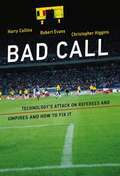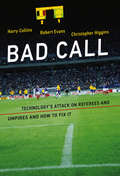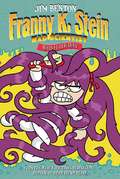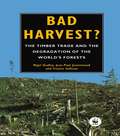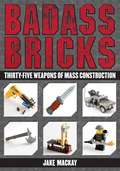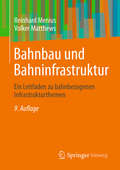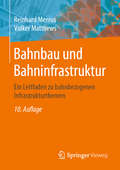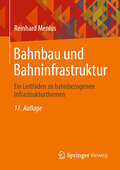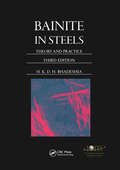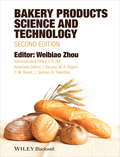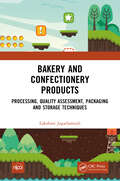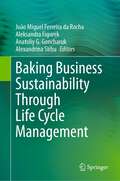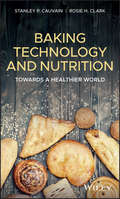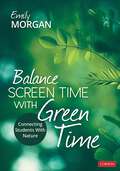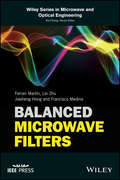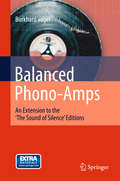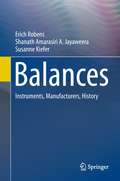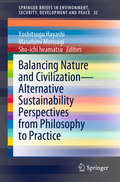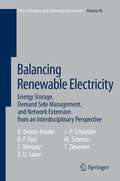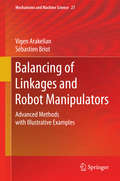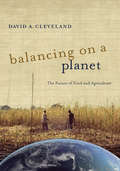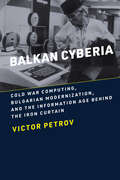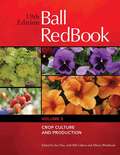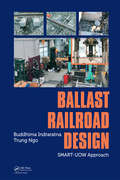- Table View
- List View
Bad Call: Technology's Attack on Referees and Umpires and How to Fix It
by Robert Evans Harry Collins Christopher HigginsGood call or bad call, referees and umpires have always had the final say in sports. Bad calls are more visible: plays are televised backward and forward and in slow motion. New technologies -- the Hawk-Eye system used in tennis and cricket, for example, and the goal-line technology used in English football -- introduced to correct bad calls sometimes get it right and sometimes get it wrong, but always undermine the authority of referees and umpires. Bad Call looks at the technologies used to make refereeing decisions in sports, analyzes them in action, and explains the consequences.Used well, technologies can help referees reach the right decision and deliver justice for fans: a fair match in which the best team wins. Used poorly, however, decision-making technologies pass off statements of probability as perfect accuracy and perpetuate a mythology of infallibility. The authors re-analyze three seasons of play in English Premier League football, and discover that goal line technology was irrelevant; so many crucial wrong decisions were made that different teams should have won the Premiership, advanced to the Champions League, and been relegated. Simple video replay could have prevented most of these bad calls. (Major League baseball learned this lesson, introducing expanded replay after a bad call cost Detroit Tigers pitcher Armando Galarraga a perfect game.)What matters in sports is not computer-generated projections of ball position but what is seen by the human eye -- reconciling what the sports fan sees and what the game official sees.
Bad Call: Technology's Attack on Referees and Umpires and How to Fix It (Inside Technology)
by Robert Evans Harry Collins Christopher HigginsHow technologies can get it wrong in sports, and what the consequences are—referees undermined, fans heartbroken, and the illusion of perfect accuracy maintained.Good call or bad call, referees and umpires have always had the final say in sports. Bad calls are more visible: plays are televised backward and forward and in slow motion. New technologies—the Hawk-Eye system used in tennis and cricket, for example, and the goal-line technology used in English football—introduced to correct bad calls sometimes get it right and sometimes get it wrong, but always undermine the authority of referees and umpires. Bad Call looks at the technologies used to make refereeing decisions in sports, analyzes them in action, and explains the consequences.Used well, technologies can help referees reach the right decision and deliver justice for fans: a fair match in which the best team wins. Used poorly, however, decision-making technologies pass off statements of probability as perfect accuracy and perpetuate a mythology of infallibility. The authors re-analyze three seasons of play in English Premier League football, and discover that goal line technology was irrelevant; so many crucial wrong decisions were made that different teams should have won the Premiership, advanced to the Champions League, and been relegated. Simple video replay could have prevented most of these bad calls. (Major League baseball learned this lesson, introducing expanded replay after a bad call cost Detroit Tigers pitcher Armando Galarraga a perfect game.)What matters in sports is not computer-generated projections of ball position but what is seen by the human eye—reconciling what the sports fan sees and what the game official sees.
Bad Hair Day (Franny K. Stein, Mad Scientist #8)
by Jim BentonFranny K. Stein is back with another laugh-out-loud experimental adventure in the eighth book in the Mad Scientist series from Jim Benton, the New York Times bestselling author-illustrator of Dear Dumb Diary and Happy Bunny.Franny K. Stein isn’t a fan of glamour. She doesn’t style her hair, the thought of wearing makeup makes her want to gag, and she couldn’t care less about wearing dressy dresses when she’d much prefer her lab coat. But sometimes Franny wonders if her mom wishes she were different. Which gives Franny an idea…for an experiment! What if she can turn the beauty products her mom loves into something more exciting? Every experiment has its experimental error, and when Franny’s hair takes on a life of its own, Franny must save the day (and her hair) to finally realize her mom loves her just the way she is.
Bad Harvest: The Timber Trade and the Degradation of Global Forests
by Jean-Paul Jeanrenaud Nigel Dudley Francis SullivanThe world's forests are disappearing at an alarming rate, and with disastrous consequences. Demand for wood and paper products ranks high amongst the causes of deforestation and forest degradation, and is now the major cause of loss in those forests richest in wildlife. There is a great deal to be done to improve the timber industry before our forests are safely and sustainably managed. Bad Harvest presents an incisive account of the role that the timber trade has played in the loss and degradation of forests around the world. It examines the environmental consequences of the trade on boreal, temporal and tropical regions, and its impacts for local people working and living in the forests. It also looks at the changing nature of the trade, and assesses current national and international initiatives to address the impacts of deforestation. Finally, the authors show how things could be improved in the future, by presenting a new strategy for sustainable forest management. Based on 15 years of extensive research - particularly work carried out by the World Wide Fund for Nature - Bad Harvest is essential reading on the subject; not only for environmentalists, but also for those in the timber trade seeking to improve the management and reputation of their product.
Badass Bricks: Thirty-Five Weapons of Mass Construction
by Jake MackayLEGO is fun. So are toy weapons. The only thing more fun is LEGO toy weapons! A compilation of badass brick weapons--some that actually even work--this book is designed for the adult brick enthusiast. Each project is original (i.e., not from a LEGO kit) and is accompanied by how-to schematics and full-color original photographs of the finished object. Dangerous and exciting projects include:TomahawkBroadswordClaymore (two-handed sword)Ninja throwing starM1911 pistolSiege towerGatling gunMK2 grenadeScythed chariotParis gunFlamethrowerAnd many more!Hobbyists love to make weapons, and this book goes far beyond the kits that are available to showcase forty projects for amazing weapons. The projects range from medieval to modern, from small hand grenades to an actual working guillotine to an assault amphibious vehicle. Badass Bricks will keep adults occupied for hours and is the perfect book for the adult brick enthusiast, weapons hobbyist, or all-around badass!
Bahnbau und Bahninfrastruktur: Ein Leitfaden zu bahnbezogenen Infrastrukturthemen
by Reinhard Menius Volker MatthewsDas Lehrbuch vermittelt anschaulich und praxisnah die bauspezifischen Grundlagen der Schienenbahnen und wendet sich prim#65533;r an Studierende im bautechnischen Hochschulbereich. Es ist eine wertvolle Erg#65533;nzung zu Vorlesungen und #65533;bungen. Dem Praktiker zeigt es, auf welchen Grundlagen z. B. bestimmte Trassierungsregeln beruhen. Neben technischem Know-how findet der Leser Themen wie Lichtraumprofile, Linienf#65533;hrung in Grund- und Aufriss, Querschnittsgestaltung, Unter- und Oberbau, Weichen und Kreuzungen, ausgew#65533;hlte Signale, Hinweise zu Bahnanlagen und Bahn#65533;berg#65533;ngen sowie zum Bauen unter Eisenbahnbetrieb und auch Grundlagen des Schienenverkehrsl#65533;rms. Der Autor bezieht sich schwerpunktm#65533;#65533;ig auf normalspurige Bahnen, also die klassischen Schienenbahnen. In der 9. Auflage wurde das von Prof. Dr. -Ing. Volker Matthews begr#65533;ndete Werk von Prof. Dipl. -Ing. Reinhard Menius weitergef#65533;hrt und komplett #65533;berarbeitet und aktualisiert.
Bahnbau und Bahninfrastruktur: Ein Leitfaden zu bahnbezogenen Infrastrukturthemen
by Reinhard Menius Volker MatthewsDas Lehrbuch vermittelt anschaulich und praxisnah die Grundlagen derSchienenbahnen und wendet sich primär an Studierende im bautechnischenHochschulbereich als wertvolle Ergänzung zu Vorlesungen und Übungen.Dem Praktiker zeigt es wesentliche Grundlagen und Zusammenhänge. DerAutor bezieht sich insbesondere auf normalspurige, klassische Bahnen. Abder 9. Auflage wurde das von Prof. Dr.-Ing. Volker Matthews begründeteWerk von Prof. Dipl.-Ing. Reinhard Menius weitergeführt, komplett überarbeitetund aktualisiert.
Bahnbau und Bahninfrastruktur: Ein Leitfaden zu bahnbezogenen Infrastrukturthemen
by Reinhard MeniusDas Lehrbuch vermittelt anschaulich und praxisnah die Grundlagen derSchienenbahnen und wendet sich primär an Studierende im bautechnischenHochschulbereich als wertvolle Ergänzung zu Vorlesungen und Übungen.Dem Praktiker zeigt es wesentliche Grundlagen und Zusammenhänge. DerAutor bezieht sich insbesondere auf normalspurige, klassische Bahnen. Abder 9. Auflage wurde das von Prof. Dr.-Ing. Volker Matthews begründeteWerk von Prof. Dipl.-Ing. Reinhard Menius weitergeführt, komplett überarbeitetund aktualisiert.
Bainite in Steels: Theory and Practice, Third Edition
by H.K.D.H. BhadeshiaThis is the third edition of the book, much expanded to include and incorporate important developments in the subject over the last fifteen years. The book represents a comprehensive treatise on all aspects of the bainite transformation, from the choreography of atoms during the phase change to length scales that are typical of engineering applications. The alloy design that emerges from this explains the role of solute additions, and the pernicious effects of impurities such as hydrogen. The picture presented is self-consistent and therefore is able to guide the reader on the exploitation of theory to the design of some of the most exciting steels, including the world’s first bulk nanostructured metal.
Bakery Products Science and Technology
by Y. H. Hui Weibiao ZhouBaking is a process that has been practiced for centuries, and bakery products range in complexity from the simple ingredients of a plain pastry to the numerous components of a cake. While currently there are many books available aimed at food service operators, culinary art instruction and consumers, relatively few professional publications exist that cover the science and technology of baking. In this book, professionals from industry, government and academia contribute their perspectives on the state of industrial baking today. The second edition of this successful and comprehensive overview of bakery science is revised and expanded, featuring chapters on various bread and non-bread products from around the world, as well as nutrition and packaging, processing, quality control, global bread varieties and other popular bakery products. The book is structured to follow the baking process, from the basics, flour and other ingredients, to mixing, proofing and baking. Blending the technical aspects of baking with the latest scientific research, Bakery Products Science and Technology, Second Edition has all the finest ingredients to serve the most demanding appetites of food science professionals, researchers, and students.
Bakery and Confectionery Products: Processing, Quality Assessment, Packaging and Storage Techniques
by Lakshmi JagarlamudiThis book is a comprehensive and practical day-to-day reference for undergraduate and postgraduate students in the discipline of Food Science and Technology. Different topics are discussed to provide a comprehensive knowledge of the theoretical as well as the applied aspects involved in processing of bakery and confectionery products to gain confidence in any dedicated reader to go for a startup in the field. It also covers information on ingredients to bakery and confectionery products, formulae and processes for bakers, equipment for bakers and confectionery units along with quality assessment and standards. It will also help those connected with industries – who supply ingredients, equipment and packaging materials for bakery and confectionery units. The book is also useful for students appearing in any competitive examination in the disciplines of Food Science, Food Science, Nutrition, and Food Technology. This title is co-published with NIPA. Taylor and Francis does not sell or distribute its print and electronic editions in India, Pakistan, Nepal, Bhutan, Bangladesh and Sri Lanka.
Baking Business Sustainability Through Life Cycle Management
by João Miguel Ferreira da Rocha Aleksandra Figurek Anatoliy G. Goncharuk Alexandrina SirbuThis timely and comprehensive text focuses on important recent advances in applied sustainability in the baking industry, connecting all of the current methods and strategies into a single book. Those involved in bread production will find the latest developments at the theoretical and practical levels, including information and communication requirements, reporting and regulatory aspects, economic and environmentally sustainable business models, supply chain management, life cycle assessment, product and organizational environmental footprints and more. For small bakery business owners to industry leaders and policymakers, governmental authorities, regulatory authorities and standardization bodies, this book offers a compilation of technical information about sustainability in the market for the bakery sector. Life Cycle Thinking In Managing Baking Business Sustainability begins by presenting basic information on the life cycle assessment and product environmental footprint of the bread industry, proposing an analysis of sustainability assessment using environmental and social footprints and providing recommendations for integral optimization of economic and environmental performance. A second section focuses on sustainability in the baking industry, providing a regional focus from Europe to The Americas to Africa and beyond. The third section takes a deep look at economic feasibility and efficiency in the bread industry, including an important chapter on the market risk and external shock effects from COVID-19, the economic viability of different scenarios for bread-based value chains, and forming efficient business models for bakeries. A final section zeroes in on the most up-to-date innovations in the current bakery industry, including the impact of bakery innovation on business resilience growth, commercial systems, and new business models in regional food systems for farmers and companies, based on multi-actor approach. Innovations within the bakery industry are at an all-time high, with new sustainability and economic models being introduced, along with associated market risks. This timely and ambitious text aims to cover all of the most recent advances and methods for successful incorporation into bakery businesses.
Baking Technology and Nutrition: Towards a Healthier World (Woodhead Publishing Series In Food Science, Technology And Nutrition Ser.)
by Stanley P. Cauvain Rosie H. ClarkA new study of the challenges presented by manufacturing bakery products in a health-conscious world The impact of bakery products upon human nutrition is an increasingly pressing concern among consumers and manufacturers alike. With obesity and other diet-related conditions on the rise, the levels of salt, fat, and sugar found in many baked goods can no longer be overlooked. Those working in the baking industry are consequently turning more and more to science and technology to provide routes toward healthier alternatives to classic cake, bread, and pastry recipes. With Baking Technology and Nutritional Research, renowned food scientist Stanley P. Cauvain and co-author Rosie H. Clark present an innovative and much-needed study of the changes taking place in the world of baking. Their discussion focuses on the new avenues open to bakers looking to improve the nutritional value of their products and encompasses all related issues, from consumer preferences to the effects of nutritional enhancement upon shelf-life. Featuring an abundance of new research and insights into the possible future of modern baking, this unique text: Offers practical guidance on developing, delivering, and promoting high-nutrition bakery products Discusses reducing ingredients such as salt, fat, and sugar for improved nutrition while preserving quality and consumer acceptability Explores how wheat-based products can be ideal vehicles for improving the nutrition of major sectors of populations Suggests real-world solutions to problems rising from poorly defined quality guidelines and inadequate dialogue between bakers and nutritionists Baking Technology and Nutrition is an indispensable and timely resourcefor technologists, manufacturers, healthcare practitioners, or anyone else working in today’s food and nutrition industries.
Balance Screen Time With Green Time: Connecting Students With Nature
by Emily MorganHarness the power of nature to nurture minds and hearts Youth spend anywhere between four and nine hours on screens every single day. Meanwhile, a growing body of research shows how detrimental excessive screen time is on physical and mental health. The antidote? Green time. Written by bestselling author and science educator Emily Morgan, Balance Screen Time With Green Time gives teachers and school leaders practical, evidence-based strategies that seamlessly incorporate the restorative power of nature into the school day. Transform learning experiences and improve student and educator well-being with: Research-based strategies that improve attention, engagement, pro-environmental behaviors, and mental and physical health while reducing stress Dozens of easy-to-implement "green breaks"—short, invigorating experiences with nature—that help students and teachers renew and refocus throughout the school day Stories of innovative educators who connect students with nature and offer meaningful ways to integrate green time while enhancing learning A curated collection of resources to support educators of all grade levels, content areas, and school environments—urban, suburban, and rural With green time, we have an opportunity to create a generation of students who are not only more connected to the natural world, but are also the environmental stewards our future so desperately needs. Balancing screen time with green time is an investment in student well-being, our collective future, and a healthier planet.
Balance Screen Time With Green Time: Connecting Students With Nature
by Emily MorganHarness the power of nature to nurture minds and hearts Youth spend anywhere between four and nine hours on screens every single day. Meanwhile, a growing body of research shows how detrimental excessive screen time is on physical and mental health. The antidote? Green time. Written by bestselling author and science educator Emily Morgan, Balance Screen Time With Green Time gives teachers and school leaders practical, evidence-based strategies that seamlessly incorporate the restorative power of nature into the school day. Transform learning experiences and improve student and educator well-being with: Research-based strategies that improve attention, engagement, pro-environmental behaviors, and mental and physical health while reducing stress Dozens of easy-to-implement "green breaks"—short, invigorating experiences with nature—that help students and teachers renew and refocus throughout the school day Stories of innovative educators who connect students with nature and offer meaningful ways to integrate green time while enhancing learning A curated collection of resources to support educators of all grade levels, content areas, and school environments—urban, suburban, and rural With green time, we have an opportunity to create a generation of students who are not only more connected to the natural world, but are also the environmental stewards our future so desperately needs. Balancing screen time with green time is an investment in student well-being, our collective future, and a healthier planet.
Balanced Microwave Filters (Wiley - IEEE)
by Francisco Medina Lei Zhu Ferran Martín Jiasheng HongThis book presents and discusses strategies for the design and implementation of common-mode suppressed balanced microwave filters, including, narrowband, wideband, and ultra-wideband filters This book examines differential-mode, or balanced, microwave filters by discussing several implementations of practical realizations of these passive components. Topics covered include selective mode suppression, designs based on distributed and semi-lumped approaches, multilayer technologies, defect ground structures, coupled resonators, metamaterials, interference techniques, and substrate integrated waveguides, among others. Divided into five parts, Balanced Microwave Filters begins with an introduction that presents the fundamentals of balanced lines, circuits, and networks. Part 2 covers balanced transmission lines with common-mode noise suppression, including several types of common-mode filters and the application of such filters to enhance common-mode suppression in balanced bandpass filters. Next, Part 3 examines wideband and ultra-wideband (UWB) balanced bandpass filters with intrinsic common-mode suppression. Narrowband and dual-band balanced bandpass filters with intrinsic common-mode suppression are discussed in Part 4. Finally, Part 5 covers other balanced circuits, such as balanced power dividers and combiners, and differential-mode equalizers with common-mode filtering. In addition, the book: Explores a research topic of increasing interest due to the growing demand of balanced transmission lines and circuits in modern communication systems Includes contributions from prominent worldwide experts in the field Provides readers with the necessary knowledge to analyze and synthesize balanced filters and circuits Balanced Microwave Filters is an important text for R&D engineers, professionals, and specialists working on the topic of microwave filters. Post graduate students and Masters students in the field of microwave engineering and wireless communications, especially those involved in courses related to microwave filters, and balanced filters and circuits will also find it to be a vital resource.
Balanced Phono-Amps: An Extension to the 'The Sound of Silence' Editions
by Burkhard VogelThis book presents the design, analysis and testing of fully balanced RIAA phono amps and measurement tools. The content of this book extends a standard reference about RIAA phono amps "the sound of silence" by Burkhard Vogel. Here, the gap is filled between a semi-balanced engine (RIAA Phono-Amp Engine I) and a fully balanced engine, the RIAA Phono-Amp Engine II. In this new book on hand, "fully balanced" means that each phono-amp stage ends up in a balanced - or in other words symmetrical - solution, differentially amplified. Un-balanced / single-ended solutions are not in the scope.
Balances: Instruments, Manufacturers, History
by Erich Robens Shanath Amarasiri A. Jayaweera Susanne KieferThe book deals mainly with direct mass determination by means of a conventional balances. It covers the history of the balance from the beginnings in Egypt earlier than 3000 BC to recent developments. All balance types are described with emphasis on scientific balances. Methods of indirect mass determination, which are applied to very light objects like molecules and the basic particles of matter and celestial bodies, are included As additional guidance, today's manufacturers are listed and the profile of important companies is reviewed. Several hundred photographs, reproductions and drawings show instruments and their uses. This book includes commercial weighing instruments for merchandise and raw materials in workshops as well as symbolic weighing in the ancient Egyptian's ceremony of 'Weighing of the Heart', the Greek fate balance, the Roman Justitia, Juno Moneta and Middle Ages scenes of the Last Judgement with Jesus or St. Michael and of modern balances. The photographs are selected from the slide-archives of the late Richard Vieweg (1896-1972) (former President of the Physikalisch-Technische Bundesanstalt, Braunschweig, Germany), of the late Hans R. Jenemann (1920-1966) (former head of the Analytical Laboratory of Schott & Gen. , Mainz, Germany) and of his wife Irene (1933-2008) and of Erich Robens.
Balancing Nature and Civilization - Alternative Sustainability Perspectives from Philosophy to Practice (SpringerBriefs in Environment, Security, Development and Peace #32)
by Yoshitsugu Hayashi Masafumi Morisugi Sho-Ichi IwamatsuThis book is an outcome of an international symposium: Sustainability –Can We Design the Future of Human Life and the Environment? which was held as a satellite event of the “Love the Earth”-Expo 2005 (Aichi, Japan). Each chapter is based on the lecture given by the following eminent researchers: Yoshinori Ishii, Hans-Peter Dürr, Yoshinori Yasuda, Minoru Kawada, Yasunobu Iwasaka, Werner Rothengatter, Hisae Nakanishi, Yang Dongyuan, Lee Schipper, Itsuo Kodama, and Yoshitsugu Hayashi.In the Part I titled “A Sustainable Relationship between Nature and Humans”, we discuss what will become of fossil fuels and petroleum, and what kind of indicators should be used to monitor the energy expended by human society. We then discuss environmental impacts caused by different civilizations and values on Nature and ethics, based on the perspective of environmental archaeology and on the discussions by Kunio Yanagita, the father of Japanese folklore study.The Part II is titled and shows “International Conflict Concerning Environmental Damage and Its Causes”. The Asian dust (Kosa) is a typical example of transboundary conflicts between nations. Another example can be found in the EU’s attempt to put in place a common motorway toll system across EU countries having different geographical and economic conditions. Finally, Part III covers the opinions and further debates on sustainable future earth based on the lectures in Parts I and II.We hope that great insights in this book will come across to readers, and be of help in steering the world towards a sustainable society in harmony with biosystems on earth.
Balancing Renewable Electricity: Energy Storage, Demand Side Management, and Network Extension from an Interdisciplinary Perspective (Ethics of Science and Technology Assessment #40)
by Christian Rehtanz Bert Droste-Franke Jens-Peter Schneider Miranda Schreurs Dirk Uwe Sauer Thomas Ziesemer Boris P. PaalAn important aim behind the restructuring of Germany's and Europe's electricity systems is to reduce the environmental burden, especially with respect to greenhouse gas emissions, of the current systems. Emissions must be brought down to a level that is sustainable in the long run and consistent with greenhouse gas emission reduction goals. Meeting these goals will require a system (as best as current knowledge suggests) that will be able to cope simultaneously with the fundamental demands for economic efficiency, environmental sustainability and supply security. Making use of existing scenarios, this study sketches such a system. It focuses in particular on auxiliary systems such as energy storage methods and network extensions. The study introduces technologies that can balance electricity in energy systems and that can serve as enabling technologies for the integration of large quantities of renewable energies in the power supply system. It begins with a discussion of normative aims for the future electricity system before continuing with a description of current policies and political developments and an overview of relevant existing energy system studies. These sections serve as background for the remainder of the study. They are followed by discussion and analysis of the growing demand for means to balance the fluctuations found in electricity generated in power systems with a high penetration of renewable energies, the potentials of diverse technologies, requirements for electrical networks, economic impacts and important legal issues. Finally, the main challenges to the achievement of developing balancing technologies and processes for renewable electricity-dominant systems are summarised and recommendations made.
Balancing of Linkages and Robot Manipulators: Advanced Methods with Illustrative Examples (Mechanisms and Machine Science #27)
by Vigen Arakelian Sébastien BriotIn this book advanced balancing methods for planar and spatial linkages, hand operated and automatic robot manipulators are presented. It is organized into three main parts and eight chapters. The main parts are the introduction to balancing, the balancing of linkages and the balancing of robot manipulators. The review of state-of-the-art literature including more than 500 references discloses particularities of shaking force/moment balancing and gravity compensation methods. Then new methods for balancing of linkages are considered. Methods provided in the second part of the book deal with the partial and complete shaking force/moment balancing of various linkages. A new field for balancing methods applications is the design of mechanical systems for fast manipulation. Special attention is given to the shaking force/moment balancing of robot manipulators. Gravity balancing methods are also discussed. The suggested balancing methods are illustrated by numerous examples.
Balancing on a Planet
by David A. ClevelandThis book is an interdisciplinary primer on critical thinking and effective action for the future of our global agrifood system, based on an understanding of the system's biological and sociocultural roots. Key components of the book are a thorough analysis of the assumptions underlying different perspectives on problems related to food and agriculture around the world and a discussion of alternative solutions. David Cleveland argues that combining selected aspects of small-scale traditional agriculture with modern scientific agriculture can help balance our biological need for food with its environmental impact--and continue to fulfill cultural, social, and psychological needs related to food. Balancing on a Planet is based on Cleveland's research and engaging teaching about food and agriculture for more than three decades. It is a tool to help students, faculty, researchers, and interested readers understand debates about the current crisis and alternatives for the future.
Balkan Cyberia: Cold War Computing, Bulgarian Modernization, and the Information Age behind the Iron Curtain
by Victor PetrovHow Bulgaria transformed the computer industry behind the Iron Curtain—and the consequences of that transformation for a society that dreamt of a brighter future.Bulgaria in 1963 was a communist country led by a centralized party trying to navigate a multinational Cold War. The state needed money, and it sought prestige. By cultivating a burgeoning computer industry, Bulgaria achieved both but at great cost to the established order. In Balkan Cyberia, Victor Petrov elevates a deeply researched, local story of ambition into an essential history of global innovation, ideological conflict, and exchange. Granted tremendous freedom by the Politburo and backed by a concerted state secret intelligence effort, a new, privileged class of technical intellectuals and managers rose to prominence in Bulgaria in the 1960s. Plugged in to transnational business and professional networks, they strove to realize the party&’s radical dreams of utopian automation, and Bulgaria would come to manufacture up to half of the Eastern Bloc&’s electronics. Yet, as Petrov shows, the export-oriented nature of the industry also led to the disruption of party rule. Technicians, now thinking with and through computers, began to recast the dominant intellectual discourse within a framework of reform, while technocratic managers translated their newfound political clout into economic power that served them well before and after the revolutions of 1989.Balkan Cyberia reveals the extension of economic and political networks of influence far past the reputed fall of communism, along with the pivotal role small countries played in geopolitical games at the time. Through the prism of the Bulgarian computer industry, the true nature of the socialist international economy, and indeed the links between capitalism and communism, emerge.
Ball Redbook: Crop Culture And Production
by Jim Nau Bill Calkins Allison WestbrookThis essential resource for professional plant growers includes techniques and advice intended for real-world greenhouse and nursery production. Information is offered on the basics of crop culture—media, nutrition, irrigation, water quality, light, temperature, crop scheduling, growth regulators, pest management, and more. In the Crops section, which is organized by botanical name, you will find details about propagation, growing on, insect and disease control, troubleshooting, and postharvest care. The plants represented in this compendium include annuals, perennials, flowering potted plants, herbs, vegetable bedding plants, and a new and detailed section on cannabis/hemp.
Ballast Railroad Design: Smart-uow Approach
by Buddhima Indraratna Trung NgoThe rail network plays an essential role in transport infrastructure worldwide. A ballasted track is commonly used for several reasons, including economic considerations, load bearing capacity, rapid drainage and ease of maintenance. Given the ever-increasing demand for trains to carry heavier axle loads at greater speeds, traditional design and construction must undergo inevitable changes for sustainable performance. Ballast is an unbounded granular assembly that displaces when subjected to repeated train loading affecting track stability. During heavy haul operations, ballast progressively deteriorates and the infiltration of fluidized fines (mud pumping) from the underlying substructure and subgrade decreases its shear strength and also impedes drainage, while increasing track deformation and associated maintenance. Features: serves as a useful guide to assist the practitioner in new track design as well as remediating existing tracks. research discussed in this book has made considerable impact on the railway industry. resulting from collaborative research between academia and industry, incorporating sophisticated laboratory tests, computational modelling and field studies. This book presents a comprehensive procedure for the design of ballasted tracks based on a rational approach that combines extensive laboratory testing, computational modelling and field measurements conducted over the past two decades. Ballast Railroad Design: SMART-UOW Approach will not only become an imperative design aid for rail practitioners, but will also be a valuable resource for postgraduate students and researchers alike in railway engineering.
